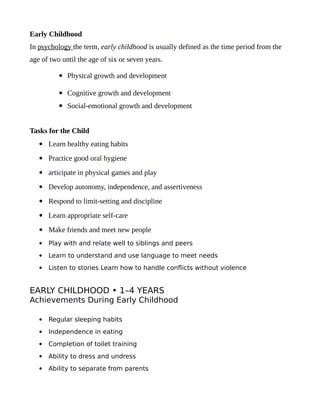
Early childhood
- 1. Early Childhood In psychology the term, early childhood is usually defined as the time period from the age of two until the age of six or seven years. ▪ Physical growth and development ▪ Cognitive growth and development ▪ Social-emotional growth and development Tasks for the Child Learn healthy eating habits Practice good oral hygiene articipate in physical games and play Develop autonomy, independence, and assertiveness Respond to limit-setting and discipline Learn appropriate self-care Make friends and meet new people Play with and relate well to siblings and peers Learn to understand and use language to meet needs Listen to stories Learn how to handle conflicts without violence EARLY CHILDHOOD • 1–4 YEARS Achievements During Early Childhood Regular sleeping habits Independence in eating Completion of toilet training Ability to dress and undress Ability to separate from parents
- 2. Progression from parallel to interactive play and sharing Loving relationships and goodbcommunication with parents and siblings Clear communication of needs and wishes Expression of such feelings as joy, anger, sadness, and frustration Self-comforting behavior Self-discipline Intelligible speech Positive self-image Demonstration of curiosity and initiative Demonstration of imaginative, make-believe, and dress-up play Social/Emotional/Behavioral Development During the dynamic years from age 1 through 4, children develop an emerging sense of themselves as individuals who live in families as well as within larger social systems. Building on the secure and trusting relationships established in the first year of life, and venturing beyond the parallel play of toddlers, the maturing young child makes friends and meets new people. The culture of the family and that of the community provide a framework within which the socialization process unfolds. The increasingly self- aware young child grapples with such complex issues as gender roles, peer and/or sibling competition, cooperation, and the difference between right and wrong. The temperamental differences that were manifested in the feeding, sleeping, and self- regulatory behaviors of the infant are transformed into the varied styles of coping and adaptation demonstrated by the young child. Some young children appear to think before they act; others are impetuous. Some children are slow to warm up while others are friendly and outgoing. Some accept limits and rules more easily than others. The range of “normal” behavior is broad and highly dependent on the match between the child’s and the caregiver’s styles. Aggression, acting out, excessive risk taking, and antisocial behaviors may appear at this time. Caregivers need to respond with a variety of interventions that set constructive limits and help children achieve self-discipline. Ultimately, healthy social and emotional development depend on how children view themselves and the extent to which they feel valued by others. -Social development is a two sided process in which children become increasingly integrated into
- 3. . , ,the larger social community as distinct individuals The process of acquiring the standards values .and knowledge of communities and society is known as socialization The way in which individual children develop a characteristic sense of themselves and a unique way to think and feel is known ( , 1983).as personality formation Damon Socialization which begins as soon as a child is born is 'especially important during early childhood as the frst understanding of the childs community is . .constructed It is a process that requires the active participation of both adults and children 'Caregivers set expectations for childrens proper behavior as well as the rewards or punishments for .their conduct Caregivers also select and create the social contexts within which children .experience their environments and learn the rules of behavior Children are active participants in .this process What they learn depends in part on their interpretation of their environments and on .what they select as important from the barrage of available information , ,Children need to understand the social categories roles rules and expectations of their families .and communities in order to function in a social world Efective socialization assures that if a child ,comes to consider herself a girl she will acquire the appropriate behavior for girls as defned by a . , ,particular social group In order to understand the requirements of this role however she must .have certain skills and abilities ,For each child the combination of characteristics that shape personality is unique since the particular mix of genetic endowment and personal experience is never completely shared with .another human being Some elements of personality are obvious immediately after birth as when .infants display a particular temperament Personality is more than individual temperament as it includes the way people conceive of themselves and their characteristic style of interacting with .others Thus individual personality development and socialization are two sides of a single developmental .coin Social development during the preschool years is closely linked to achievements in cognitive .and linguistic skills All the feedback received from the social environment is crucial to development .of a sense of self One of the most remarkable facts about social development is the extent to which
- 4. .children adopt as necessary the rules defned by their social group By the time children reach their 6th birthday a great deal has been learned about the roles they are expected to play and how to , ,behave in accordance with them how to control anger and aggressive feelings and how to respect .the rights of others